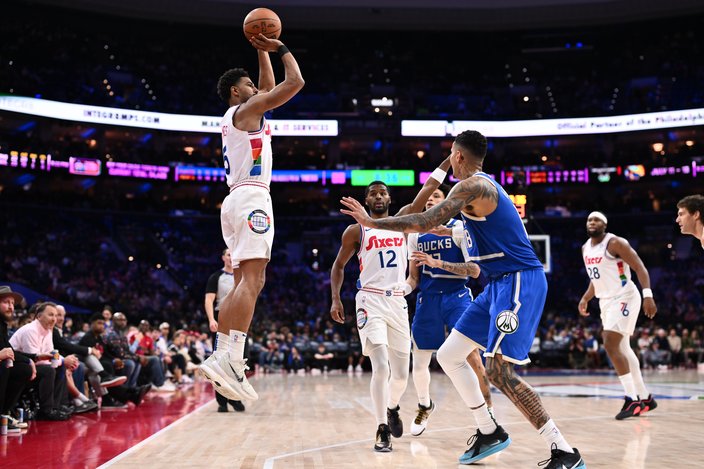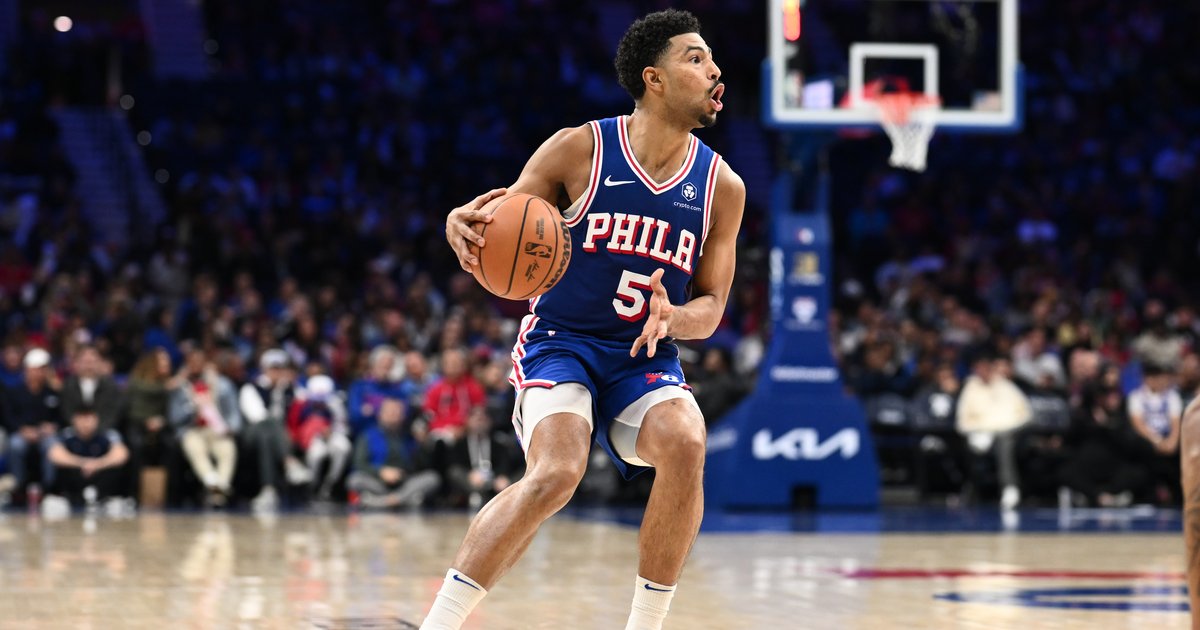It felt inevitable heading into 2025 NBA free agency that Quentin Grimes, the Sixers’ prized 25-year-old restricted free agent, would remain on the board for a while. With the right to match any offer sheet he signs with another team, the Sixers hold the cards, with Grimes largely at their mercy. And this is one of the worst markets for restricted free agents in recent memory, as only the Brooklyn Nets possess any cap space — and they seem singularly focused on using it to take other teams’ unwanted salaries for assets in return.
So, as nearly every starting-caliber player on the market has already agreed to terms on new deals, Grimes is still out there despite impressing the league with a massive scoring binge over the final two months of his fourth NBA season. So are fellow restricted free agents Jonathan Kuminga and Josh Giddey, learning the same lesson as Grimes: teams with restricted rights are not going to hand over competitive offers without any real incentive to do so.
Grimes has every right to reject offers from the Sixers that he knows are not commensurate with his production and age — particularly because they are long-term deals, and this is his first chance to cash in in a major way as an NBA player. However, the Sixers offering Grimes money that he cannot otherwise command would just be irresponsible. So Grimes and the Sixers find themselves in a common NBA holding pattern.
What can Grimes command, then? If Brooklyn suddenly experiences a change of heart and makes a move for Grimes, the Nets currently have $16 million in cap space. They could increase that figure to $24 million by waiving four players on non-guaranteed contracts. But Brooklyn pursuing Grimes, Kuminga, Giddey or any other young restricted free agent has been one of the more obvious concepts imaginable entering free agency, and there has yet to be any indication that the Nets have actually considered it in any meaningful fashion.
Otherwise, there are a few teams that have yet to touch their non-taxpayer’s mid-level exception and can do so without experiencing other complications. That offer tops out at four years and just over $60 million. Among the teams with that tool at their disposal, which could make sense for Grimes: the Washington Wizards, Utah Jazz and Portland Trail Blazers. Washington and Utah are in the phase of their rebuilds where accumulating young talent should be the goal, while Portland could try to steal a valuable young player who gives them some offensive juice without subtracting from their defensive-minded nature.
This is where that thought dies: if Grimes signed a four-year, $60.6 million offer — the entire value of the non-taxpayer’s MLE — the Sixers would just match it. Grimes would earn $14.1 million in the first season of the deal, a number that is more than manageable, with raises of just over $700,000 in each season. The offer looks like this:
| Season | Salary |
| 2025-26 | $14,104,000 |
| 2026-27 | $14,809,200 |
| 2027-28 | $15,514,400 |
| 2028-29 | $16,219,600 |
| Total | $60,647,200 |
That is a no-doubt-about-it match for the Sixers, and teams like Washington, Utah and Portland know that.
That fact is important, because historically teams do not ink offer sheets with restricted free agents unless they think there is a very real chance the player’s incumbent team will not match the deal. Said incumbent team has 48 hours to make a decision, and every minute in early July is precious for a team trying to spend money. Having significant financial resources tied up for two whole days and leaving empty-handed can be a gut punch for an organization with any serious ambitions to maximize those dollars in free agency.
But do teams like those care if they make an offer that gets matched? Washington and Utah have full rosters already, and if they offered Grimes the mid-level exception and the deal got matched, they could save their MLE to use as a trade exception later in the season. Portland has little to lose by making an offer, unless they are aiming to swing another high-profile trade after flipping Anfernee Simons for Jrue Holiday.
Maybe the path of least resistance here is the Sixers offering Grimes a slight bump over those numbers. Grimes can say he outdid his market and the Sixers keep him relatively pleased without having to entertain complicated sign-and-trade deals that make the team worse — or run the risk of Brooklyn making a spirited push for him at the 11th hour, possibly forcing the Sixers to choose between losing Grimes and entering the NBA’s punitive second apron. The Sixers would quietly keep Grimes on a valuable contract that is incredibly trade-friendly down the line, even if it is not instantly one of the best contracts in the NBA.
If the Sixers add about $1.5 million to their starting salary on a full mid-level deal, their ability to offer slightly higher raises (eight percent, not five percent) takes the offer up to an appealing round figure:
| Season | Salary |
| 2025-26 | $15,625,000 |
| 2026-27 | $16,875,000 |
| 2027-28 | $18,125,000 |
| 2028-29 | $19,375,000 |
| Total | $70,000,000 |
This could become an even greater standoff if teams like Washington and Utah actually use their mid-level exceptions elsewhere or Brooklyn’s cap space dwindles even further. The Sixers would have a chance to squeeze Grimes into a remarkably valuable deal — the sort that would be among the best in the league. It would not just make him a stellar trade asset, but also give the team a chance to secure outstanding production per dollar on the next playoff-competitive Sixers team, whether that is in 2025-26 or later.
Restricted free agency is designed to give all control to teams. It is generally only until a player ventures into free agency after their second contract that they can exert any sort of leverage. But restricted free agents have one nuclear option: accepting the qualifying offer. The qualifying offer is a one-year deal that the team has to extend in order for the player to become restricted, and it is usually nothing more than a formality.
For Grimes, the qualifying offer is worth $8,741,210. Why would he accept it? Any player who accepts their qualifying offer has the ability to veto any trades for an entire season, and then they get to become an unrestricted free agent the following offseason, free to sign with any team. Grimes would make nearly twice as much money as he did last season and bet on himself staying healthy and continuing his ascent, setting himself up to be a 26-year-old unrestricted free agent with an extremely desirable skillset in a market that projects to be a whole lot friendlier to free agents.
But just as history tells us that teams do not bother making offer sheets they know will be matched, it tells us that players taking the qualifying offer is not nearly as common as the logic above might lead someone to believe it should be. In fact, ESPN NBA front office expert Bobby Marks said during an appearance on The Ryen Russillo Podcast earlier this week that only five players have signed a qualifying offer in the last 10 years.
That is because accepting the qualifying offer is a much easier concept to fathom in theory than it is a risk to actually incur in practice. As we have seen too often in the last few months, a player’s career — and sometimes the course of an entire franchise — can change at a moment’s notice. Grimes’ salaries over the life of his four-year rookie scale contract added up to just over $11 million. As a late first-round pick, he has not made a ton of money for someone who is demonstrably productive.

 Kyle Ross/Imagn Images
Kyle Ross/Imagn Images
Quentin Grimes averaged 21.9 points and shot .373 percent from three-point range after arriving to Philadelphia.
Even if Grimes re-signs with the Sixers on a four-year, $48 million contract that falls well short of his hopeful price tag, he will secure generational wealth and the certainty that comes with it. If he takes the qualifying offer and suffers a late-season injury or has an outlier three-point shooting season in the wrong direction, what happens then? The Sixers have three guards on their roster who are likely more significant long-term building blocks than Grimes in Tyrese Maxey, Jared McCain and VJ Edgecombe. What if Grimes has a slow start to the season and McCain and Edgecombe both quickly surpass him on the depth chart, with Grimes ending up in a non-prominent role? None of these scenarios seem likely, but they are all plausible and would tank his value — possibly even more than the restricted tag has done this summer.
Above all of the risks that every restricted free agent runs by picking up their qualifying offer, there is a fact unique to Grimes: his career has been littered with instability.
Grimes had a great thing going in New York after the Knicks traded for him on draft night, eventually starting for a playoff team in his second NBA season. But then Donte DiVincenzo came to New York and Grimes had a slow start to the season, enabling DiVincenzo to overtake his spot in the rotation. Months later, Grimes was traded to help the Knicks land a pair of veteran role players on expiring contracts. He might have been able to emerge on a young Detroit Pistons team that experienced an exciting resurgence this season, but he had only played six games for his new team to end last year before being traded to the Dallas Mavericks over the summer. Grimes was having a career year in Dallas, but the Mavericks traded Luka Dončić out of absolutely nowhere, and the return package happened to include Max Christie, a player under long-term contract thought to be quite similar to Grimes. Suddenly, Grimes was on the move again, this time headed to Philadelphia.
Outlining all of that history is done to make the following point: nobody should have a deeper understanding of how quickly things can change in the NBA than Grimes, and it stands to reason that he entered this summer intent on securing the long-term certainty that has escaped him for his entire career.
That is one of the many factors playing into the Sixers’ hands here. This process has already taken longer than many would have hoped, but the fact of the matter is that the Sixers remain in pole position to retain Grimes and do so on a team-friendly contract. The exact framework of such a deal will depend on the activity of teams like Brooklyn, Washington, Utah and Portland. But unless Grimes is willing to take an enormous risk — one that is especially dangerous for him specifically — the Sixers hold the cards.
Follow Adam on Twitter: @SixersAdam
Follow PhillyVoice on Twitter: @thephillyvoice
(Except for the headline, this story has not been edited by PostX News and is published from a syndicated feed.)

